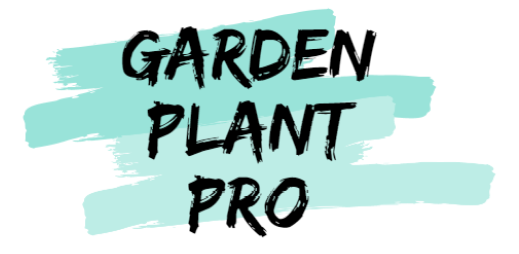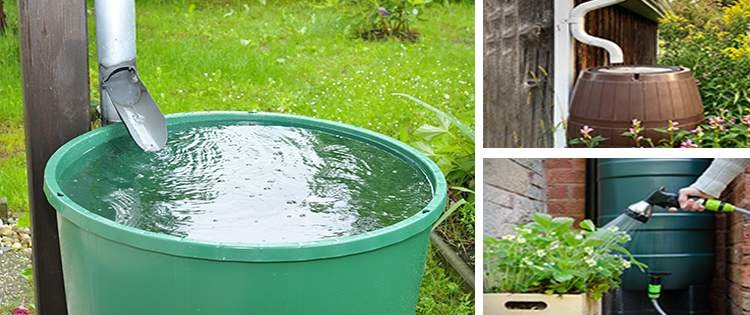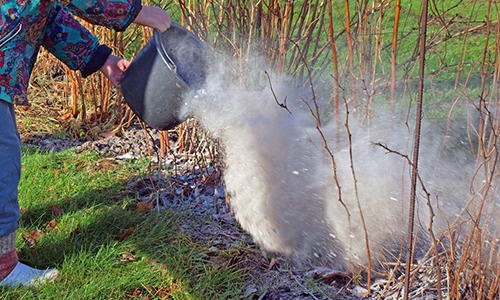Rhubarb is a distinct and flavorful vegetable that may add a tart edge to your cooking.
This popular vegetable is simple to raise and will give you with a plentiful yield for many years. Growing rhubarb in your vegetable garden is a terrific way to add some excitement to your crop, whether you’re a seasoned gardener or just getting started.
In this guide, we’ll go over everything you need to know to grow rhubarb effectively, from choosing the correct kind and planting site to caring for your plants and harvesting your delicious product. You’ll be on your way to cultivating your own juicy and tasty rhubarb in no time.
A Brief History
Rhubarb has a long and storied history that dates back thousands of years. It is believed to have originated in the western part of Asia and has been cultivated for centuries in China for its medicinal properties.
In the 1800s, rhubarb became popular in Britain due to the accidental discovery of forced rhubarb, which is grown during the winter months. This breakthrough accelerated the growing popularity of rhubarb to the point of mania, with people growing it in their gardens and greenhouses.
Rhubarb was first introduced to North America in the 19th century and has since become a popular ingredient in pies, jams, jellies, sauces, and other dishes. Today, it is grown commercially around the world and is a staple crop in many countries.
Whether you plan on growing rhubarb for its culinary uses or just for its beauty in your garden, it’s important to understand its history and what makes it so special.
Nutritional Benefits
Rhubarb is packed with essential nutrients, making it a great addition to your diet.
It is an excellent source of vitamin K, which is an essential vitamin for bone health and blood clotting. It also contains high amounts of vitamin A and fiber. Studies show that rhubarb fiber may lower cholesterol levels. Additionally, a half cup of cooked rhubarb provides more than 20% of the daily recommended value of vitamin K1.
Vitamin A is important for eye health, and Rhubarb also contains vitamins C and K. These vitamins are essential for strong bones, cardiovascular health and kidney health. Eating rhubarb regularly can help to relieve constipation and boost overall health.
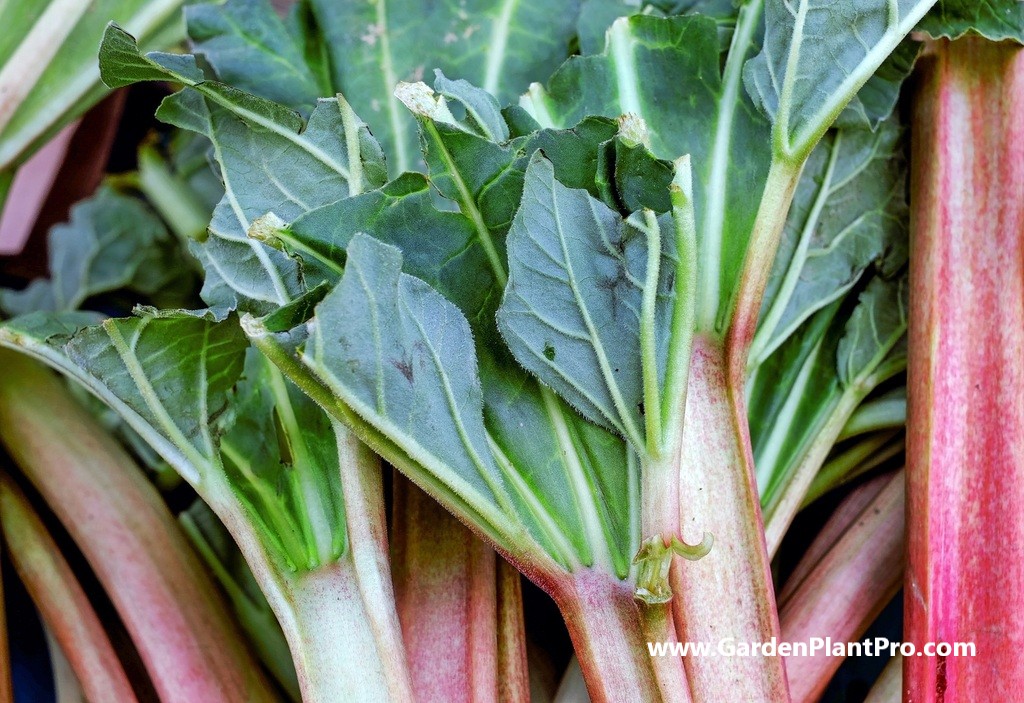
Common Varieties & Their Uses
Rhubarb is a versatile and popular vegetable with a range of varieties to choose from.
Depending on the variety, it can provide a tart or sweet flavor to your dishes.
When selecting rhubarb for your garden, it is important to consider the climate and soil conditions as well as the variety. There are some varieties that are better suited for cooler climates, while others prefer warmer climates.
Victoria is one of the most popular varieties of rhubarb. It produces long, red stalks with a tart flavor. The Victoria rhubarb is a hardy variety that grows best in cooler climates.
The Timperley Early variety is an early-maturing rhubarb that produces vibrant red stalks with a sweet flavor. This variety grows best in warmer climates and is ideal for those who want to enjoy their rhubarb sooner rather than later.
Cherry Red is another early maturing variety that produces deep red stalks with a tart-sweet flavor. This variety has been bred to be disease resistant and can be grown in both warm and cool climates.
The Valentine variety produces long, dark red stalks with a sweet flavor and is well suited for both cooler and warmer climates. This variety is also disease-resistant and easy to grow.
For those looking for an ornamental touch in their garden, the Crimson Red rhubarb has beautiful dark-red stalks and large leaves that make for an attractive addition to any landscape. The Crimson Red has a tart flavor and grows best in cooler climates.
Rhubarb plants can live for years if properly cared for.
Every year, add compost to the soil and keep plants well watered during dry months. Remove the dead leaves when the top growth dies back in autumn to expose the plant’s roots to the cool weather. This encourages new shoots for the following season.
DIY PROJECT: Collect rainwater no matter where you live...
This DIY project is the best way to legally collect rainwater NO MATTER where you live. Get chlorine-free water, cut down on your water bills, and have enough for an emergency situation or to water your garden. Read More Here...
When To Sow
When it comes to sowing rhubarb seeds, the best time to do so is in late autumn for spring growth, or early spring. Plant your seeds 2.5 cm (1in) deep and then thin out the seedlings to 15cm (6in) apart, selecting the most vigorous plants. Seeds should be sown directly in the ground or in trays of seed raising mix.
If you opt to plant rhubarb crowns instead, they should be cut from divisions of vigorous parent plants and planted with the crown just below the soil’s surface. To do so, use a sharp spade or long knife to cut through the plant’s crown. Put the entire segment in the ground or in a container (that is bigger than the off-cut). New leaves will appear as the plant begins to establish roots.
Planting rhubarb crowns is a quicker and easier way to get your plants established than sowing seeds, and you can break one established rhubarb plant up into several new ones, but it does require some patience as it will take a year or two for your plants to reach full maturity.
Once you have planted your rhubarb either from seed or crowns, you should ensure that young plants are protected from extreme temperatures and sun exposure. You should also water regularly and fertilize your plants every few weeks during the growing season. If done correctly, your rhubarb should be ready for harvest after two or three years.
Choosing A Suitable Location In The Garden
Choosing the right location for growing rhubarb is essential for successful cultivation.
It is important to find an area that receives full sun, as this will help the plants thrive. It should also have good drainage, as rhubarb does not do well in soggy soil.
The soil should be relatively fertile, and it is a good idea to add some organic matter such as compost or aged manure when preparing the ground. This will help to improve the fertility and structure of the soil, and will provide essential nutrients for the plant.
Before planting, it is also important to consider how much space you have available in your garden. Rhubarb can grow quite large and require plenty of space, so it is important to ensure you have enough room for it to spread out.
It is also important to ensure that your chosen location has adequate protection from strong winds and hot afternoon sun. Once planted, you should water frequently and fertilize on a regular basis to ensure healthy growth. Rhubarb can be harvested in late spring and early summer, and stored or preserved as desired.
Preparing The Soil
Preparing the soil for rhubarb is essential for a successful harvest. The ideal soil for rhubarb should be well-draining and fertile. Poor drainage can cause the plants to rot, so it is important to choose a site with a soil that allows for good drainage.
Adding compost, rotted manure, or dehydrated cow manure to the topsoil will help improve fertility and loosen the soil. Make sure not to exceed 1/3 concentration of peat moss when adding it to the soil as too much can cause issues with drainage.
You can sow rhubarb seeds in late autumn or early spring, either indoors or directly into the ground. Before sowing, prepare the sowing site by weeding and raking it to a fine texture. Additionally, rhubarb prefers an acid soil with a pH of 5.0-6.5, so avoid planting it near concrete paths or other areas that could affect pH levels.
Once you have prepared your sowing site, you can sow your rhubarb seeds or seedlings. Water well and keep the soil moist until seedlings are established and then water regularly throughout the growing season. Fertilize with a general purpose fertilizer before flowering begins and again at harvest time to ensure healthy plants and an abundant harvest.
Planting The Seeds, Seedlings Or Crowns
Planting the seeds or seedlings is the next step in growing rhubarb in your garden. When sowing seeds, it’s best to start them indoors several weeks before the last expected frost of spring.
Using an indoor seed starting tray or peat pots filled with a potting mix or garden soil amended with compost will give your seeds a good start. Soaking the seeds in warm water for a few hours prior to planting will help to boost germination. Sow the seeds in trays of seed raising mix and transfer into pots once they are large enough to handle.
If you are planting seedlings, make sure to choose a spot in the garden that receives good sun and has plenty of organic matter such as compost or aged manure worked into the soil. Make sure to plant at least two feet apart and make sure the crown is just above ground level. If you are planting multiple rows, space them at least four feet apart. Water in well after planting and mulch around the plants to help retain moisture and reduce weed growth.
Once planted, rhubarb seedlings need regular water, fertilizer, and occasional thinning or culling of overcrowded plants. Water deeply once a week during dry spells, fertilize with a balanced fertilizer once every few months and thin out crowded plants when necessary.
Do you have some charcoal in your house right now? We call charcoal a “miracle leftover” for anyone who wants to be a little more self-sufficient and cut costs. That’s because it can help you with so many different things around the house and garden. You can even use it to make an energy-free fridge. Read More Here...
Be careful not to overfertilize as this can lead to delayed flowering and reduced fruit production. Also keep an eye out for common pests and diseases that may affect your rhubarb plants and take steps to address them as soon as possible.
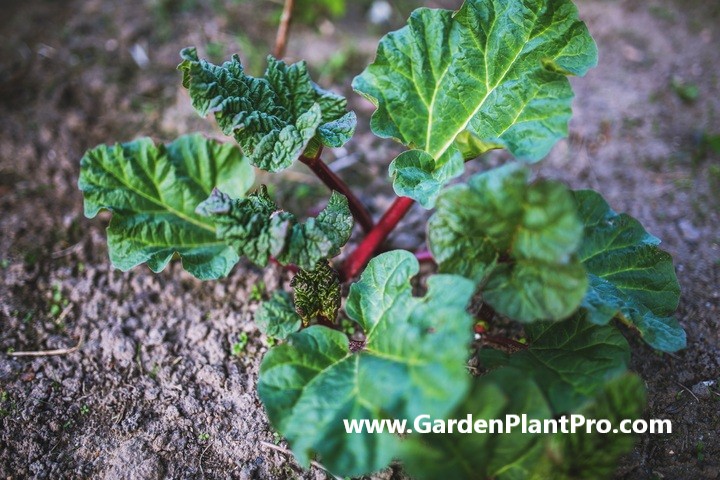
Caring For The Seedlings
Caring for the seedlings is an important part of successfully growing rhubarb. Watering and fertilizing are key components of this process, so be sure to follow the instructions carefully.
It’s important to water your rhubarb plants well and consistently throughout the growing season. Rhubarb prefers a moist soil, so check the soil regularly and water as needed. If temperatures rise too high, it can be helpful to provide extra shade or water more frequently.
Fertilizing is also essential for healthy, productive rhubarb plants. Feed your plants with a balanced fertilizer at the start of spring and again mid-summer for best results. You can also add organic matter like compost or manure to the soil during planting or throughout the growing season to help improve soil fertility.
In addition to watering and fertilizing, it’s important to cover young plants with mulch in spring to protect them from sudden cold snaps. If you’re growing from crowns, plant them so they are just below the soil surface and cover with mulch or soil mix to keep moisture in.
By following these steps, you can ensure your rhubarb seedlings have all they need to thrive and produce a bountiful harvest of delicious stalks.
Watering & Fertilizing
Rhubarb plants need consistent watering, especially during the warmer months of the year. The soil should be kept moist but not saturated. If the soil is too dry, the leaves will start to wilt and the plant may become stunted. It’s best to water deeply, but infrequently, allowing the soil to dry out between watering.
Fertilizing is also important for rhubarb plants. We recommend fertilizing each plant with about 1/2 cup of 10-10-10 fertilizer in early spring and again in the fall. Apply the fertilizer in a circle around the plant, about 6 inches from the base of the stem. For an extra boost of nutrients, you can also place some sheep pellets into a mesh stocking or similar and keep submerged in a bucket of water. This liquid can then be used to regularly feed your rhubarb plants.
The year after planting, it’s a good idea to fertilize your rhubarb plants in early spring, before the plant begins to sprout significantly. Use an all purpose 10-10-10 fertilizer or chicken manure for best results. While 10-10-10 fertilizer is widely available, it’s important to read and follow all instructions carefully as over fertilization can damage or even kill your rhubarb plants.
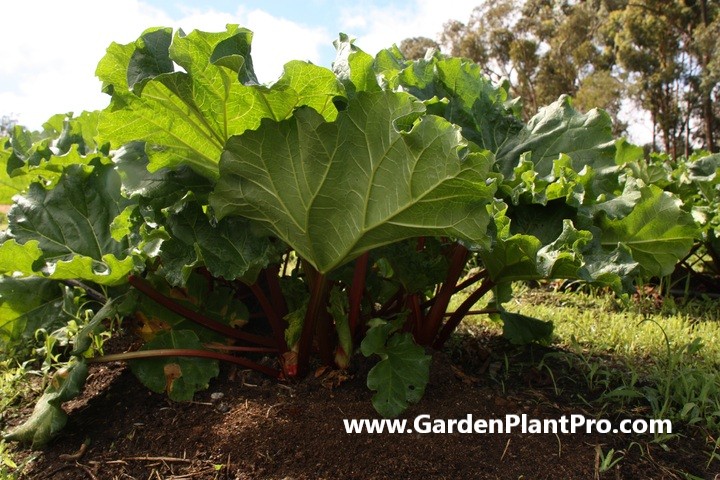
When & How To Harvest
Harvesting rhubarb is an easy and rewarding task.
The best time to harvest rhubarb is in autumn and spring when the stalks are 12 to 18 inches in length. To begin, firmly grasp a stalk close to the ground and twist and pull it away from the main stem. Make sure not to cut the stalk, as this can cause rot. Once it breaks free of the plant, it is ready for harvesting.
It’s important to wait until at least the second year after planting before harvesting, as this gives root reserves time to accumulate. When flowers appear, remove them from the plant so that the energy goes back into stem production.
When harvesting, be sure not to take too much at once – no more than a third of the stalks should be removed in any given season. Doing so will ensure that there is still enough nourishment left in the plant for continued growth and production. Plants can live for years if properly cared for and continue to produce fresh rhubarb season after season.
Rhubarb can be stored in a cool place for up to two weeks before being used in recipes or preserved for future use. If you wish to preserve your harvested rhubarb, you can freeze it by blanching it first or make jams, chutneys and sauces with it.
Storing & Preserving
Storing and preserving rhubarb is a great way to enjoy its sweet-tart flavor long after the growing season has ended. Properly stored and preserved rhubarb will remain fresh for up to a year. When selecting rhubarb, choose firm, tender, well-colored stalks. Wash, trim, and cut them to the sizes you need for recipes. You can freeze rhubarb raw or store it in the refrigerator.
To store in the refrigerator, cut the rhubarb stalks and refrigerate in a covered container or tightly wrap in plastic or aluminum foil. For freezing, blanch the stalks for 2 minutes in boiling water before freezing. Once frozen, place them in an airtight freezer bag or container.
When it comes time to use your frozen rhubarb in recipes, take out what you need and let it thaw naturally at room temperature. For cooked recipes like pies, simply add frozen rhubarb directly to your pie filling ingredients and bake as usual.
CASE STUDY: We've been living off the grid for the last 40 years...
In all that time an electric wire has never been connected to our house. We haven’t gotten or paid an electricity bill in over 40 years, but we have all the electricity we want. We grow everything we need, here, in our small backyard. We also have a small medicinal garden for tough times. Read More Here...
You can also preserve rhubarb by drying it or making jam or preserves with it. To dry rhubarb, cut into thin slices and spread on a baking sheet lined with parchment paper. Place the baking sheet in an oven set to its lowest temperature (usually around 150°F) and leave it there until all of the moisture is gone from the slices (about 4-6 hours). Once dried, store them in an airtight container for up to 6 months.
If you want to make jam or preserves with your rhubarb, there are plenty of recipes available online that are easy to follow. Simply cook down the rhubarb with sugar and other ingredients until thickened then pour into sterilized jars and seal tightly. Dried or preserved rhubarb can be enjoyed all year round!
Common Diseases & How To Control Them
Rhubarb is an easy-to-grow plant that can be grown in most temperate regions.
However, like all plants, it can be susceptible to diseases and infestations by insects. In this section, we will cover common diseases and how to control them.
Rhubarb is prone to a few fungal diseases, such as rust, scab and downy mildew. To prevent and control these fungi always remove and destroy the affected plant parts and ensure good air circulation around the plants by avoiding overcrowding. Incorporating organic matter such as a good quality compost or well-aged manure into the soil prior to planting and a small amount of fertilizer will also help to promote healthy growth and reduce the risk of disease.
Other common problems include crown rot which is caused by overly wet soil or poor drainage, crown gall which can cause stunted growth, and rhizome rot which is caused by nematodes. To prevent these issues, it is important to make sure that the soil is well drained, free from debris and that you do not overwater your plants. If you are growing rhubarb in containers, make sure they are at least 12 inches deep with good drainage holes.
It is also important to dig and split rhubarb roots every 3 to 4 years to keep them healthy and free from disease. This will also help to keep your plants productive over time.
Pests such as aphids, slugs and snails can also cause damage to rhubarb plants. The best way to protect your plants is by using companion planting techniques such as planting garlic or onions on either side of your rhubarb plant or using an organic insecticide.
Common Pests & How To Control Them
Common pests and diseases can easily threaten the health of your rhubarb plants. To keep your plants healthy and producing, it’s important to identify and treat any pest or disease issues in a timely manner.
Slugs and snails are common pests of rhubarb, particularly in moist climates. These pests feed on the stalks and leaves of the plants, leaving behind ragged holes that can weaken the plant. Slugs and snails can be controlled by handpicking them from the plants, using a bait such as beer or iron phosphate, or by introducing beneficial predators such as ground beetles.
Beetles can also be a problem for rhubarb, especially during wet weather. These pests feed on the leaves of the plant, leaving behind small holes. To control these pests, remove any infested foliage and dispose of it away from your garden. You can also use an insecticidal spray or introduce beneficial predators such as ground beetles.
Aphids are small sap-sucking insects that can cause damage to rhubarb plants. They leave behind honeydew which can attract ants and other pests, as well as cause sooty mold on the leaves. To control aphids, use an insecticidal soap or horticultural oil spray to kill them on contact. You can also introduce beneficial predators such as ladybugs or lacewings to feed on the aphids.
With regular monitoring and proper care, you can keep your rhubarb plants healthy and productive for many years to come.
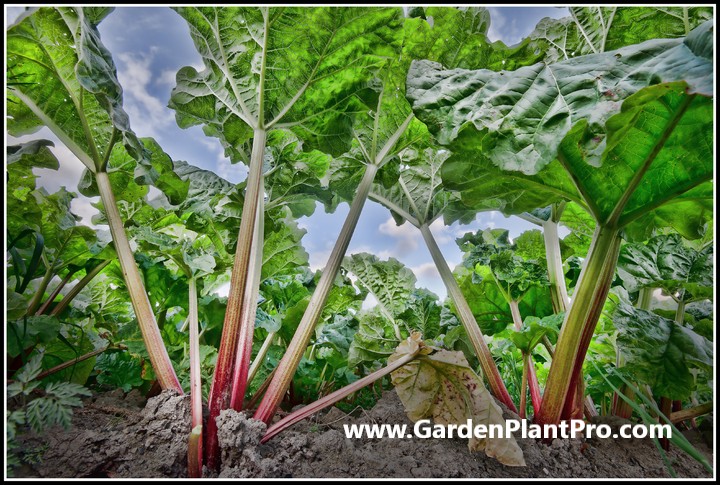
Beneficial Companion Plants
Companion planting is an effective way to ensure your rhubarb plants are healthy and productive. By planting compatible vegetables and herbs next to each other, you can help deter pests, increase yield, and improve the quality of your rhubarb crop.
When it comes to companion plants for rhubarb, there are several vegetables and herbs that you can use. Kale, turnips, cabbage, broccoli, beans, strawberries, onions, garlic and cauliflowers are all great options. These plants will not only help keep pests away from your rhubarb crop, but they can also enrich the soil with essential nutrients.
It’s important to note that there are some plants that should not be planted near rhubarb. Melon, black walnut, cucumber, pumpkin, and dock should be avoided as they can cause harm to your rhubarb crop.
Herbs such as catnip, chives, dill, oregano, parsley, rosemary, sage, tarragon and thyme are also good companions for rhubarb plants. Not only do these herbs help deter pests from attacking your rhubarb crop but they can also add flavor to your home-grown produce.
When planting companion plants for your rhubarb crop it’s important to remember that the plants need space in order to grow and thrive. Planting them too close together can lead to overcrowding which can stunt growth and reduce yield.
By taking the time to plan out a companion planting strategy you can ensure that your rhubarb crop is healthy and productive for years to come. With the right combination of vegetables and herbs you can maximize the yield of your home-grown produce while reducing pest damage at the same time.
Using Your Home Grown Rhubarb
Once you have harvested your home grown rhubarb, there are a variety of ways to use it. It can be enjoyed fresh, cooked, preserved, or frozen for use at a later date.
Fresh rhubarb is a delicious addition to salads, smoothies, and even as a topping on fruit-based desserts. For the best flavor, remove any tough strings from the stalk before using.
Cooking rhubarb helps to bring out its natural sweetness. Before begin cooking rhubarb, remove any harmful leaves and cut the ends. The stalks should then be chopped into small pieces and placed in a pot with a little water or fruit juice. Bring the liquid to a boil, then reduce to a low heat.
To taste, add sugar or honey, as well as any other spices, such as cinnamon or ginger. Cook for 10-15 minutes, or until the rhubarb has softened and the liquid has thickened into a sauce or compote. Let the cooked rhubarb to cool before using it in your recipe.
Preserving rhubarb is a great way to enjoy it all year round. You can freeze it or make it into jams or jellies. To freeze rhubarb, wash the stalks and cut them into small pieces. Place them in an airtight container and store in the freezer for up to six months. When you’re ready to use it, thaw it out before using in recipes or smoothies.
No matter how you choose to enjoy your home grown rhubarb, there are plenty of ways to make use of this versatile vegetable.
